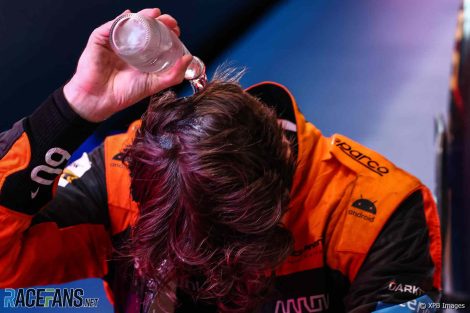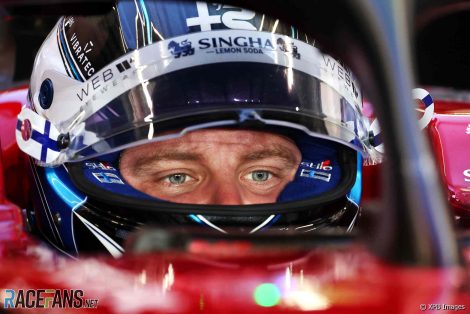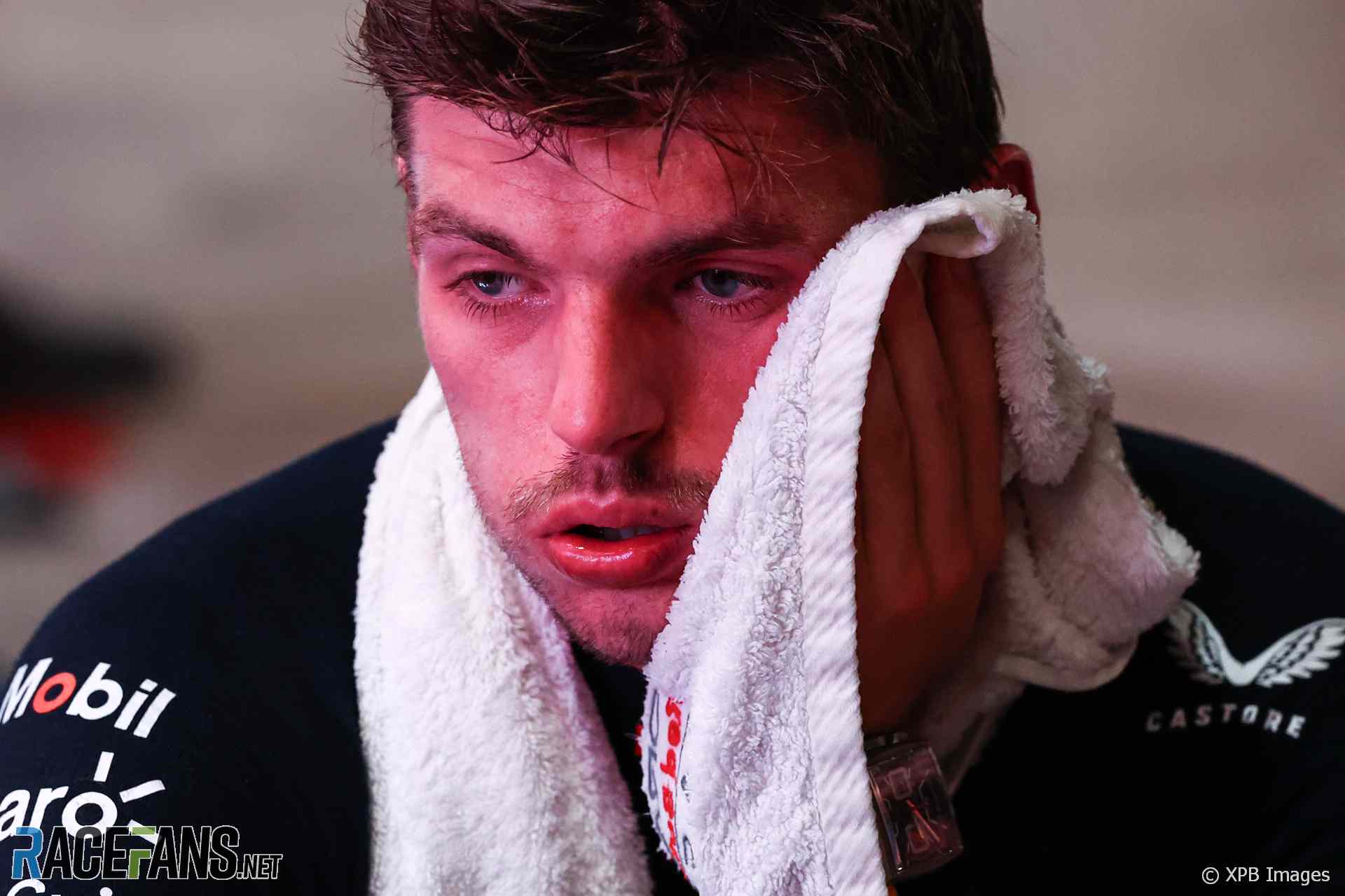Conditions during the Qatar Grand Prix were close to unbearable for drivers due to the punishing combination of extreme heat, energy-sapping humidity and high cornering forces.
At least one was sick in his car, another withdrew during the race and some said they came close to passing out. With air temperatures still over 31C as the night race began, humidity at a punishing 75% and little wind, drivers found the conditions were at or even beyond the limit of what they could stand.It was “just too, too hot” to drive, said Yuki Tsunoda. “I didn’t want to open the visor because sand was also coming through the visor and I can feel the sand is in my eyes,” said the AlphaTauri driver. “But if I close it, it’s just insane that amount of heat. Much worse than expected.”
Kevin Magnussen admitted he “felt nauseous at times” during the race and “got really dizzy” once he stopped at the end of it.
Several drivers had to take a break to cool down before speaking to RaceFans and other media after the race. “I’ve just been in an ice bath and it goes to my bones and now suddenly I’m shivering,” said George Russell.
“It was an absolutely brutal race, by far the most physical race I’ve ever experienced. I felt close to sort of fainting in that race. I’ve never experienced anything like it before.”
Qatar isn’t the only hot climate drivers race in and they prepare for the hot conditions. But Russell quickly found himself at the limit of what he’d prepared for.
Advert | Become a RaceFans supporter and
“I felt ill during this race,” he said. “I had to ask my engineer to give me encouragement just to try and take my mind away from it.

Russell was also convinced the conditions on Sunday were too close to being too much. “Today was beyond the limit, I think, of what was acceptable for driving,” he said.
“If over 50% of the grid were saying they’re feeling sick, couldn’t drive, close to passing out – you don’t want to be passing out when you’re driving 200 miles an hour down the straight and that’s how I felt at times. Any hotter I think I’d have retired because my body was going to give up.”
Race-winner Max Verstappen was no exception, saying “these kind of temperatures are just too extreme”.
“When I saw the weather before coming here I was not looking forward to it,” he admitted. “It has nothing to do with more training or whatever. I think some of the guys who were struggling today are extremely fit, probably even fitter than me.
Advert | Become a RaceFans supporter and
“But just the whole day it’s like you’re walking around in a sauna. Then in the night the humidity goes up. The races are quite long.

Even the most experienced Formula 1 driver of all time, Fernando Alonso, who participated in his 375th event last weekend, could recall few occasions when conditions had been quite as torrid.
“I think it was one of the hardest for sure,” said the Aston Martin driver. “I think Malaysia, when we were racing in Sepang in daytime, I remember those to be very extreme. I think Bahrain 2009, it was like 41 degrees. It was extremely hot, that one. And I think this one, for sure in the top three.”
However the Losail International Circuit differs from both those tracks as it has only one long straight in which the drivers could gain some respite.
Alonso admitted that following two days of practise at the circuit, he did not expect conditions in the race would be so punishing.
Advert | Become a RaceFans supporter and
“It was a surprise to be honest because [it] was not that bad in the free practice,” he said. “Maybe it was windy or something and today we missed that wind or something, that ventilation.

He wasn’t the only driver who felt the race should be used as a reference for future events to judge when conditions have become too demanding for drivers. Valtteri Bottas described the race as “torture”.
“I would say harder than Singapore[‘s race]. The temperature in the cockpit starts to be almost too much, I think it’s getting to the limit that somebody is going to have a heatstroke. Honestly, the feeling is like torture in the car.”
He said F1 needs to impose a limit on how hot conditions can be during a race, as drivers cannot be expected to take the decision for themselves.
“Every driver will try to complete the race. You’re not going to stop if you still can drive. But at some point it becomes unhealthy and risky.”
Sunday’s race should serve as the upper limit F1 would not go beyond in the future, Bottas believes. “Any hotter than this would be not safe,” he said. “I wouldn’t go hotter than this.”
Bringing the F1 news from the source
RaceFans strives to bring its readers news directly from the key players in Formula 1. We are able to do this thanks in part to the generous backing of our RaceFans Supporters.
By contributing £1 per month or £12 per year (or the equivalent in other currencies) you can help cover the costs involved in producing original journalism: Travelling, writing, creating, hosting, contacting and developing.
We have been proudly supported by our readers for over 10 years. If you enjoy our independent coverage, please consider becoming a RaceFans Supporter today. As a bonus, all our Supporters can also browse the site ad-free. Sign up or find out more via the links below:
Advert | Become a RaceFans supporter and
2023 Qatar Grand Prix
- Albon fears Qatar GP conditions risked creating dangerous “wet bulb effect”
- Alonso: New-spec fireproofs and pre-race anthem timing made Qatar heat worse
- Magnussen admits he took “too long to learn” Losail circuit
- Analysis: Sargeant’s Qatar radio reveals his painful struggle to end point-less run
- Alfa Romeo ‘finally understand their upgrade’ Bottas believes as team target Williams





Moshambles (@moshambles)
9th October 2023, 18:09
That’s my nightmare. Perhaps some mandatory driver cooling is needed if these conditions are to be experienced again. I hate the idea of drivers feeling they have to go beyond what’s tolerable like that. No shame in stopping, if you’re about to pass out or have a panic attack.
Fer no.65 (@fer-no65)
9th October 2023, 18:22
What if they monitor cockpit temperatures across the grid and if it gets to a certain level, the race is red flagged so they can all take a break and have a nice cold drink?
I know it could produce all sorts of controversies, but that’s a definite threshold that would be easily measurable, and it’s for their safety after all. They red flag races for debris or barrier repairs, it makes sense they’d red flag the race if the driver’s health is in danger. Football and tennis allow timeouts when the conditions are too extreme.
Also, as I said yesterday, if MotoGP shortened their race last time out in India because of the conditions, surely F1 can do the same. Even by a few laps it could make a huge diference. Or as Alonso says, delay the race a bit…
Jere (@jerejj)
9th October 2023, 18:41
The race already got postponed from 17:00 (the originally-chosen start time) to 20:00, but irrelevant for the future with the upcoming November-December switch that makes earlier post-sunset start times ideal again, like in 2021 when 17:00 indeed was the start time, so that matter is more about the time of year rather than start time per se.
Nick T.
9th October 2023, 19:19
It’s the first first time this has EVER happened. F1 fans are always about overreacting. The biggest issue was that the drivers never have to do quali lap after quali lap due to the overly cautious tire lap limit.
Fer no.65 (@fer-no65)
9th October 2023, 19:28
I’m not overreacting. I think with the current climate change the probabilities of having extreme weather go up. The FIA has already announced they’ll discuss measures to avoid this sort of thing happening in the future.
Fer no.65 (@fer-no65)
9th October 2023, 19:30
It’s also important this is discussed because it will also mean measures taken in lower categories.
anon
9th October 2023, 22:43
Nick T., if anybody seems to be overreacting, it seems to be you and the fake claim that “It’s the first first time this has EVER happened” – which is quite demonstrably wrong.
On the contrary, you will find many recorded instances of drivers who had problems with heat stress, and multiple instances where it ended with medical care being required. The 1982 Brazilian GP is a particularly famous example, where Riccardo Patrese had to retire from the race with heat stress and Nelson Piquet being hospitalised after collapsing and losing consciousness after the podium ceremony.
If you take Fernando Alonso, he has had first hand experience of the impact of severe dehydration. The reason why he picked out the 2009 Bahrain GP is because he required medical treatment for severe dehydration after that race, with the mechanics having to help him to get out of the car and to the medical centre as he was incapable of walking without their aid.
some racing fan
10th October 2023, 0:06
Like anon said, that is way wrong. Other examples other than Brazil ‘82? How about Argentina ‘55, when Fangio drove for 3 hours in 40C (104F) weather and a track temperature of 51C (124F), and his Mercedes‘s bodywork scalded his leg so badly it took him 3 months to recover? Or Argentina ‘77, held in similar conditions? Or Brazil ‘78? Or Dallas ‘84, when the ambient temperature was 41C (106F) and the track temp was a scarcely believable 65C (150F)? The track broke up so badly that there was only one line.
Nick T.
10th October 2023, 7:34
You guys are seriously using examples from nearly 50 years ago? I was obviously referring to modern F1, which I consider basically the early 90s and onward. There were no races in which most of the field reported getting sick. I am not against using common sense to avoid a repeat of what happened, but the last thing we need is yet more enshrined rules that will lead to circumstances where no racing is run in conditions that aren’t actually dangerous like with what F1 now tolerates in terms of wet weather.
MacLeod (@macleod)
10th October 2023, 8:09
As you said this race was over the limit and very dangerous an closer one:2009 Bahrain was also one on or over the limit but that was hushed by Bernie. And there were more recent races on the border…
A red flag for a cooling and drinking break for safety isn’t something strange to consider. If these athletes like Bottas are experiencing heatstrokes effects we all know this was over the limit.
Aquila_GD
10th October 2023, 7:57
Anon and some racing fan are legends of motorsport. You guys must be like 100 year old racing fans
MacLeod (@macleod)
10th October 2023, 8:10
Someone like me i sat in a F1 car in the sixties of Jim Clark in Zandvoort then you can gues my age not 100 yet.
Tifoso1989 (@tifoso1989)
10th October 2023, 12:14
@fer-no65
F1 will simply prevent such rule from being implemented if it will interfere with the broadcasters’ plans.
Jere (@jerejj)
9th October 2023, 18:38
32 isn’t even the highest ever during a race & the Singapore GPs regularly feature figures on both side of 30 & some European events had mid-30s in 2018-2020, so nothing different purely figure-wise & Middle East events typically aren’t as humid as those in Southeast Asia or Miami, so merely an exception for that region caused by time of year & lack of wind, etc.
However, the most important thing is that from next season onwards, Qatar GPs will have bearable temps again, like in 2021 & as for Alonso’s reference, he mixed-up the Bahrain GPs because the 2005 race featured 41C on race day despite being hold in early-April, so abnormally warm as an isolated exception that year while the 2009 event wasn’t particularly hot despite being taking place towards the month’s end.
Fer no.65 (@fer-no65)
9th October 2023, 19:29
Didn’t he also complete the whole 2005 Bahrain race without having the drink? I think it malfunctioned or something, he was visibly unwell in the podium that day.
Alianora La Canta (@alianora-la-canta)
9th October 2023, 20:35
@jerejj Humidity will have been as big an issue as the raw heat, since evaporation is a key means of keeping body temperature stable. Qatar apparently had close to 100% humidity, which would not have helped.
Alianora La Canta (@alianora-la-canta)
9th October 2023, 20:38
Sorry, I need to edit that. I misread the figure. (75% is considered below average in the UK, but the UK is usually cooler than Qatar was. Sand-based deserts are usually low humidity, which compensates somewhat for the high heat. Singapore is both high heat and high humidity. Singapore combines both, which is a big reason that it is so tough every year. The fact the weather was so much more temperate on Friday and Saturday may not have helped either).
Simon
9th October 2023, 23:05
@jerejj
2006 GP Masters had air temp of 31C and track temp of 59C, so eat it I guess?
moctecus (@moctecus)
9th October 2023, 18:43
F1 needs heat stress regulations. Plenty of other sports, including on the amateur level, have them. That means shortening or outright cancelling events based depending on conditions using metrics like wet-bulb or wet-bulb global temperature. Some racing series, including FIA WEC, limit cockpit temperatures and mandate effective cooling solutions. That would also be a good idea for F1.
Even Qatar has heat stress regulations since a couple of years ago. Above a wet-bulb globe temperature (WBGT)
index of 32.1°C all work must stop. Based on the temperature and humidity figures floating around, this number would have been well exceeded inside the cockpits. Unfortunately, F1 drivers don’t have the same protections as Qatari workers…
Bullfrog (@bullfrog)
9th October 2023, 19:27
Pirelli must be kicking themselves for not thinking of a mandatory drinks break every 18 laps…
PacificPR (@streydt)
10th October 2023, 8:13
Haha. Great one. Ice-cream for every one with a 3 choice topping – Red, Yellow or White!
melanos
10th October 2023, 23:38
Kimi would have loved it
steelhd
10th October 2023, 21:46
The solution is simple. What is needed is a heat index standard for night races (no direct sunlight) and a wetbulb globe index standard for day races (with direct sunlight) just like any other first world sport or occupation.
Stash (@stash)
12th October 2023, 7:13
If you watched Sky News Australia some of their commentators would ask, “What climate change?” and they would attribute your barbecue being on fire as due to a lack of back burning; not that you lit it.